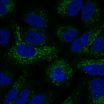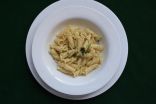The researchers used high-resolution time-lapse imaging of the developing brains of pupal fruit flies (Drosophila melanogaster) paired with mathematical simulations to unravel a trick of neural wiring that had stumped neuroscientists for decades. They discovered three simple rules that may explain how the complicated visual system of the humble fruit fly - with its eight-hundred-lens compound eyes - self-organizes as it grows. The authors said a similar approach could one day help us understand the rules governing the development of our own, much more complex brains.
The paper, titled, "The Developmental Rules of Neural Superposition in Drosophila," appears online June 25, 2015 ahead of print in the July 2, 2015 issue of the journal Cell. The new discovery began as a collaboration among three co-senior authors: Lani Wu, PhD, and Steven Altschuler, PhD, professors of pharmaceutical chemistry at the UC San Francisco School of Pharmacy, and Peter Robin Hiesinger, PhD, professor of neurobiology at Freie Universität Berlin and the NeuroCure Cluster of Excellence, Berlin, when the three scientists were all working at the Green Center for Systems Biology at UT Southwestern Medical Center in Dallas. Brain wiring is complex, and the molecular and genetic instructions that make it so are just as complex, said Altschuler. But at least in this case, he said, it turns out that somewhere in the middle "there's a level of description that is simple enough that you can literally write simple software code to implement it."
The fundamental discovery of the new paper is that the seemingly complex neural circuit connecting the fly's compound eye to its brain can be wired by following three simple, pre-programmed rules.
This discovery "gives us hope that maybe one day we can really understand other complex biological systems in terms of simple rules," said co-senior author Wu.
The researchers used high-resolution 2-photon imaging, which uses precisely focused lasers to let scientists peer deep into living tissue, to track the development of the visual system for 25 hours during fly larval development. These time-lapse images quickly revealed an anatomical shift in the relationship between the Drosophila eye and brain that had never before been detected, and enabled the research team to precisely follow the biological sleight of hand as axons from the eye reached out and wired themselves into the circuitry of the fly brain.
Study co-lead author Marion Langen, PhD, now a post-doctoral researcher in the Altschuler and Wu laboratory at UCSF, remembers thinking "Nobody has observed this before? How is that possible?" she said. "That's when it became really fun."
These new biological insights enabled Altschuler and Wu to build simulations to explain the process. It was a process of gradual refinement, Altschuler said, but over three years new insights from the imaging data and mathematical models started to converge on a surprisingly simple algorithm.
Neurobiologists have long studied the fruit fly brain as a relatively simple system where the rules of wiring may be easier to work out than in the human. But even the fly brain requires remarkable feats of biological engineering to build itself from scratch.
The researchers chose to tackle a particularly thorny wiring problem called "neural superposition," which has to do with how the fly's compound eye wires itself up to the brain. The fruit fly eye is composed of 800 facets, called ommatidia, each of which acts like a tiny eye. Behind the lens of each facet is a ring of light-sensitive cells (photoreceptors) that captures light from a small region of the fly's visual world, and send these signals down long axonal "cables" to piece together a complete visual map within the fly's brain.
Here's where the wiring trick starts: Just like your two eyes, neighboring facets of a fly compound eye see overlapping patches of the world. In order to avoid double vision, the human brain has to combine the overlapping visual information from our two eyes. In fruit flies this has to happen 800 times - for each eye.
Imagine plugging 800 different monitors, keyboards, routers and the like, each with six different cables, into 800 different computers, and you may start to grasp the challenge of getting this wiring problem right. In fact, depending on how you count, there could be something like half a million different ways it could go wrong, Altschuler said. The question of how the brain of a developing fruit fly pupa does it in 20 hours with almost perfect accuracy has puzzled neuroscientists for decades.
The problem, Altschuler said, is that in the past "they could not watch it unfold live. They had no way to visualize the process and reason about it mathematically."
Hiesinger is an expert in high-resolution brain imaging, and had long been fascinated by the superposition problem. "The question of how to wire a brain has driven my research since graduate school," he said. In previous research, Hiesinger has demonstrated that the fly visual system is "a model for how a complicated neural circuit can be genetically hard-wired." The new paper, he said, "for the first time really revealed the developmental algorithm that executes this genetic code."
The researchers discovered that rather than solving a difficult 3d braiding problem, developing axons from the eye can find their targets by following three simple steps:
1) Scaffold. Axons from the eye reach out into the brain and create a stable, lattice-like infrastructure around their targets.
2) Extend. From the tips of these axons, finger-like feelers called growth cones reach out toward the correct targets. Growth cones carrying the same visual information from different facets of the eye (which happen to come from different photoreceptor types because of the eye's own crystal-like organization) reach out with seemingly pre-programed angles and timing so that they all converge at the same target in the brain.
3) Stop. Extending growth cones come to a halt when they reach the correct target. Based on computer simulations, growth cones do a better job finding the right target when they can detect one another converging from different directions than when they rely solely on a signal from the targets themselves.
The new findings support Altschuler, Wu and Hiesinger's intuition that many apparently complex systems in biology are the product of a simple set of developmental rules. This isn't a new idea - it was one of the reasons the fly eye was chosen as a model system for more complex brains back in the 1960s and 70s, Altschuler said. But with the biological community's present focus on mapping convoluted neural circuitry and testing complex genetic interactions, "our approach is currently a bit countercultural," he said.
Brain wiring is complex and the molecular and genetic instructions that make it so are almost equally complex, Altschuler said. "It's not obvious that all systems in biology will have at their heart a simple explanation," he said. But perhaps many complex systems just await the right combination of observation and computation to crack the code.
The researchers are now conducting a more thorough search of all the possible algorithms growth cones might use to get to the right spot. They also hope to bring their combination of high-resolution imaging and computation to identify simple developmental algorithms in higher animals, such as the visual system of the mouse.
The other co-authors were co-lead author Egemen Agi of Freie Universität Berlin and the NeuroCure Cluster of Excellence, Berlin and Altschuler and Wu's son Dylan Altschuler, now an undergraduate at Princeton University, who was 16 years old when he contributed to the research.
INFORMATION:
This work was supported by a Green Center for Systems Biology Postdoctoral Fellowship at UT Southwestern (to M.L.), the National Institute of Health (RO1EY018884, RO1EY023333 (to PRH); R01CA133253, R01GM071794 to SJA; and CA185404, CA184984, R01GM071794 to LFW, the Institute of Computational Health Science at UC San Francisco (to L.F.W. and S.J.A.) and the Muscular Dystrophy Association (MDA275948) and the Freie Universität Berlin and the NeuroCure Cluster of Excellence, Berlin (to PRH).
UC San Francisco (UCSF) is a leading university dedicated to promoting health worldwide through advanced biomedical research, graduate-level education in the life sciences and health professions, and excellence in patient care. It includes top-ranked graduate schools of dentistry, medicine, nursing and pharmacy, a graduate division with nationally renowned programs in basic, biomedical, translational and population sciences, as well as a preeminent biomedical research enterprise and two top-ranked hospitals, UCSF Medical Center and UCSF Benioff Children's Hospital San Francisco.

